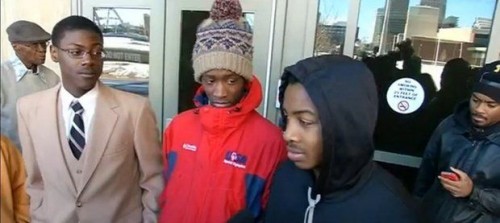I know, the Republicans have declared that racism is over, but we all read that wrong. What they really want to do is declare that talking about racism is over. We all know that the Republican Party is the most racist party in the country — they actually depend on fomenting racist attitudes to get elected nowadays — so they have a vested interest in getting us to shut up about racism in the US.
That way we wouldn’t notice events like this: three high school kids waiting for a bus their coach arranged to take them to basketball practice get arrested. For loitering and obstructing the sidewalk. Wait, waiting is what you’re expected to do at a bus stop, right? Yes, but waiting while black is apparently a crime in Rochester, New York.

Three boys (l-r) Daequon Carelock, Wan’Tauhjs Weathers and Raliek Redd were arrested in Rochester while waiting for bus to basketball scrimmage
I’m sure the cops were confirmed in their righteous efforts to keep riff-raff off the streets as soon as they heard those names: Daequon, Wan’Tauhjs, and Raliek. I wonder if the kid on the right was actually wearing a hoody while waiting for the bus? So many racial signifiers, so many justifications for arrest. You want evidence for structural racism in America? There it is.
And here’s another example: white people resisting attempts to even teach them about racism. At Minneapolis Community and Technical College, Shannon Gibney was teaching about structural racism in a communications class — it’s a rather important topic and appropriate to the subject — when students complained.
[One of the white students asked,] ‘Why do we have to talk about this in every class? Why do we have to talk about this?’ I was shocked… It was not in a calm way. His whole demeanor was very defensive. He was taking it personally. I tried to explain, of course, in a reasonable manner — as reasonable as I could given the fact that I was being interrupted and put on the spot in the middle of class — that this is unfortunately the context of 21st century America.
Another white male student said, ‘Yeah, I don’t get this either. It’s like people are trying to say that white men are always the villains, the bad guys. Why do we have to say this?’
I tried to say, ‘You guys are trying to take it personally. This is not a personal attack. We’re not all white people, you white people in general. We’re talking about whiteness as a system of oppression.’
And so I’m quite familiar, unfortunately, with how that works — and how the institutional structures and powers reinforce this white male supremacy, basically, and that sort of narrative, and way of seeing the world.
And so I said, ‘You know, if you’re really upset, feel free to go down to legal affairs and file a racial harassment discrimination complaint.’
“Why do we have to talk about this.” That’s like the common whine of every entitled, selfish, child of privilege: do not question my right to have all the things, do not challenge my status, do not ask me to look down and notice all the people I’m trampling, do not ask me to recognize the oppressed as human beings. It was entirely right of her to inform them that they could go complain to the administration, and it is entirely right that they did so.
Two white guys complaining that their teacher was teaching them about racism? You might think that it’s a foregone conclusion that Minneapolis Community and Technical College would dismiss that concern pretty quickly. You’d be wrong. Structural racism, remember?
The vice president of student affairs at MCTC filed a formal reprimand of Shannon Gibney. Against a black teacher teaching a class about racism!
“I definitely feel like I’m a target in the class. I don’t feel like students respect me,” she continued. “Those students were trying to undermine my authority from the get-go. And I told the lawyer at the investigatory meeting, ‘You have helped those three white male students succeed in undermining my authority as one of the few remaining black female professors here.'”
MCTC doesn’t have to worry. Word will get around that the school is only for white folks, and their student body and faculty will get whiter and whiter, and conflict will be minimized, and the white men will be affirmed in their smug privilege, and all will be well as long as we don’t look down.
We’ve got a few of the same smug people at UMM, but at least our administration doesn’t support them. But even here, the magic word “diversity” can be used to mask inaction and even direct discussion of the problem. Talking about racism is over. Continuing to demand discussion about it is grounds for a reprimand.

